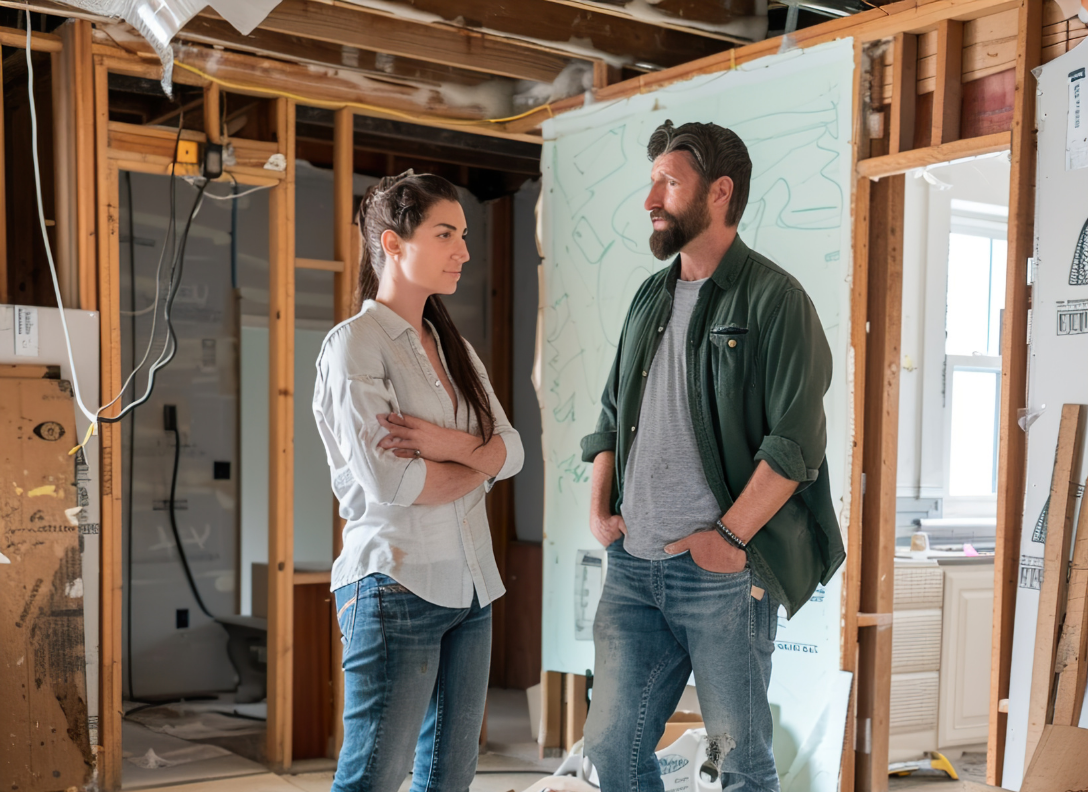“Renovating adds value” is one of those lines you hear constantly from contractors, home improvement shows, and even friends who’ve recently updated their homes. The idea is simple: put money into upgrades, and you’ll get even more back when you sell.
But here’s the truth: in 2025, not all renovations add value, and some can actually hurt resale.
Rising material costs, labor shortages, and shifting buyer priorities mean the gap between smart renovations and wasted money is wider than ever. Some projects (like kitchens, bathrooms, and energy efficiency upgrades) consistently bring strong ROI, while others (like luxury pools, over-customized finishes, or extravagant home theaters) deliver little more than personal enjoyment.
This blog is your complete guide to answering the key question: Do renovations really increase property value, and which ones are worth it?
We’ll cover:
- The economics behind renovation ROI.
- Renovations that add value in today’s market.
- Projects that don’t pay off.
- Regional and cultural differences in ROI.
- Mistakes homeowners make.
- FAQs with long, detailed answers.
- A conclusion with a step-by-step renovation framework.
By the end, you’ll know exactly where to put your money if you want both comfort today and a strong return tomorrow.
The Economics of Renovation: Why Some Projects Pay Off and Others Don’t
Renovations are not guaranteed profit-makers. Their ROI depends on three main factors:
- Buyer Demand – If buyers in your area prioritize modern kitchens and bathrooms, those upgrades add value. If they don’t care about pools or wine cellars, those projects won’t pay off.
- Cost vs Value – A $40,000 remodel that increases home value by $30,000 is still a net loss. ROI is about what buyers are willing to pay extra for, not how much you spent.
- Neighborhood Ceiling – Every neighborhood has a maximum price range. Spending $120,000 on upgrades in a $300,000 area will never recoup full costs because buyers won’t pay beyond market limits.
The lesson: Renovations should align with buyer preferences and neighborhood norms, not just your personal taste or budget.
Top Renovations That Increase Property Value
1. Kitchen Remodels
- Cost Range: $20,000–$40,000 for mid-range, $50,000–$80,000+ for upscale.
- ROI: 70–85% for mid-range, 50–60% for upscale.
Why it works: Kitchens are the heart of the home. Buyers almost always tour this room first and base much of their perception on it.
2025 Buyer Trends:
- Quartz or natural stone countertops.
- Energy-efficient appliances.
- Functional layouts with open flow.
- Neutral color palettes (white, gray, natural wood).
Pro Tip: Minor remodels (new counters, cabinet refacing, updated fixtures) often bring higher ROI than major luxury remodels because they modernize without overspending.
2. Bathroom Upgrades
- Cost Range: $10,000–$25,000 mid-range, $30,000–$50,000 upscale.
- ROI: 55–75%.
Why it works: Modern bathrooms signal cleanliness and “move-in ready” appeal. Outdated bathrooms are often deal-breakers.
2025 Buyer Trends:
- Walk-in showers with frameless glass.
- Double vanities.
- Large-format tiles in neutral tones.
- Smart toilets or heated floors in upscale homes.
3. Curb Appeal Improvements
- Cost Range: $5,000–$15,000.
- ROI: Often 100%+ for small projects.
Why it works: First impressions matter. Landscaping, exterior paint, modern front doors, and exterior lighting can raise perceived home value by 5–10%.
High-ROI Curb Appeal Projects:
- Professional landscaping.
- New garage doors.
- Fresh siding or power washing.
- Outdoor lighting for safety and aesthetics.
4. Energy Efficiency Upgrades
- Cost Range: $5,000–$30,000 depending on scope.
- ROI: 60–80%.
Why it works: In 2025, buyers place strong value on lower utility bills. Efficiency also adds eco-appeal.
Key Upgrades:
- Solar panels (with rebates, often net-positive).
- Insulation and weatherproofing.
- Energy-efficient windows and HVAC.
- Smart thermostats and appliances.
5. Basement and Attic Conversions
- Cost Range: $20,000–$60,000.
- ROI: 65–80%.
Why it works: Increasing usable square footage almost always increases value. Buyers value livable basements and attic spaces for offices, gyms, or in-law suites.
Renovations That Rarely Pay Off
- Luxury Pools – Installation can exceed $80,000, but ROI is often under 40%. Many buyers see pools as maintenance headaches.
- Over-Customization – Themed rooms, bold tile choices, or eccentric layouts narrow your buyer pool.
- Ultra-Luxury Appliances – Buyers in mid-range neighborhoods won’t pay extra for chef-grade kitchens.
- Garage Conversions Without Proper Permits – Many buyers value garage storage/parking more than converted space.
Regional Differences in Renovation ROI
- U.S. Suburbs: Kitchens, baths, and basement finishes dominate ROI. Outdoor living spaces (decks, patios) are increasingly valuable.
- Canada: Energy efficiency and winterized upgrades (triple-pane windows, heated driveways) add top value.
- Europe: Attic conversions, compact kitchen upgrades, and modular storage outperform flashy remodels.
- Asia: Space optimization, like folding walls, smart storage, and efficient kitchens, brings higher ROI than luxury projects.
ROI depends not just on the project, but on where and how you do it.
Mistakes Homeowners Make
- Over-renovating for the neighborhood. You won’t get luxury ROI in a starter-home area.
- Ignoring permits. Illegal work reduces value and creates resale headaches.
- Following short-term trends. Bold colors, open shelving, or ultra-niche designs may age poorly.
- DIY gone wrong. Buyers notice sloppy finishes. Cheap DIY work lowers perceived value.
- Forgetting hidden costs. Financing, disruption, and maintenance often reduce actual profit.
FAQs
Q1: Do all renovations increase home value?
No. Kitchens, baths, and energy-efficient upgrades usually add measurable value, but lifestyle renovations (wine cellars, pools, theaters) often don’t. Think of projects as “value” or “enjoyment.” Value projects appeal broadly; enjoyment projects are personal.
Q2: How do I know if my renovation will add value in my area?
Check comparable homes nearby. If similar homes all have upgraded kitchens and yours doesn’t, a remodel likely pays off. If no one in your area has high-end pools or gyms, those won’t return full value. Research your neighborhood’s “value ceiling” before starting.
Q3: Are DIY renovations worth it?
They can be if done well. Painting, landscaping, or cosmetic upgrades are great DIY projects. But electrical, plumbing, and structural work should be left to professionals. Poor workmanship reduces value and can even create safety issues.
Q4: What renovations are buyers prioritizing in 2025?
Energy efficiency is huge. Buyers want solar, insulation, and efficient systems as much as they want style. Open kitchens, modern baths, home offices, and smart-home tech are also priorities post-pandemic.
Q5: Should I renovate before selling?
If your home is outdated compared to comps, small updates (paint, fixtures, curb appeal) almost always help. Large remodels are riskier buyers may prefer to customize themselves. Focus on updates that make the home feel clean, modern, and move-in ready.
Q6: Do renovations affect appraisal value?
Yes. Appraisers consider condition and improvements, but not dollar-for-dollar. A $40,000 kitchen may raise the appraisal $25,000. Square footage conversions add more measurable appraisal value than purely cosmetic projects.
Q7: Is it better to renovate for myself or for resale?
Balance both. If you plan to stay long-term, prioritize your lifestyle. If you may sell soon, focus on broad, neutral upgrades that appeal widely. The best projects offer enjoyment now and ROI later.
Renovations can increase property value, but only if chosen strategically. The key is understanding what buyers in your area want, how much they’ll pay, and where the neighborhood ceiling is.
When Renovations Add Value
- Kitchens and bathrooms.
- Energy-efficient systems.
- Curb appeal upgrades.
- Adding usable space.
When Renovations Don’t Pay Off
- Overly niche or personal projects.
- Luxury beyond neighborhood norms.
- Illegal or poor-quality work.
5-Step Renovation ROI Framework
- Research comps to see what features buyers expect.
- Set a budget that aligns with your neighborhood ceiling.
- Prioritize broad appeal over niche trends.
- Hire professionals when needed to avoid devaluing your home.
- Balance lifestyle and resale so you enjoy upgrades now while keeping ROI strong.
The next decade will see buyers valuing sustainability, smart homes, and flexible spaces. Solar panels, EV charging stations, and multipurpose home offices are set to become tomorrow’s “must-haves.” Renovating with these trends in mind means your home stays competitive longer.
Renovations aren’t guaranteed profit. They’re tools. Used wisely, they increase comfort today and property value tomorrow. Used poorly, they drain money without adding resale value. In 2025, the smartest homeowners approach renovations with both their lifestyle and the market in mind.




